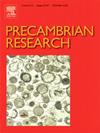Southward migration of the Neoarchean magmatism? petrogenesis of the dioritic-tonalitic-trondhjemitic gneisses in the Guyang area, Inner Mongolia, North China Craton
IF 3.2
2区 地球科学
Q2 GEOSCIENCES, MULTIDISCIPLINARY
引用次数: 0
Abstract
In the Guyang area, numerous late Neoarchean to early Paleoproterozoic DTTG (diorite-tonalite-trondhjemite-granodiorite) are exposed across different litho-tectonic units. This study investigates the nature and tectonic implications of these DTTG. Zircon U-Pb dating of seven representative samples yields an age range of 2396–2537 Ma, showing a southward younging trend. The dioritic rocks exhibit lower Sr/Y and (La/Yb)N values and various Cr, Ni contents, and zircon Hf isotopic compositions. Ancient inherited zircons suggest that these rocks formed from partial melting of an ancient lower crust, with mantle material involvement. The Guyang TTG exhibit relatively high Sr/Y, (La/Yb)N, and Eu/Eu* values, typically indicating derivation from partial melting of hydrated basalts at high pressure. However, the similarity in whole-rock Nd and zircon Hf isotopic compositions between the Guyang TTG and dioritic rocks, along with mixing modelling results between the hornblendite xenoliths and the trondhjemites, suggests a common source. This indicates the TTG were derived from the differentiation of dioritic magma, with amphibole as the primary fractional phase. Thermodynamic and trace element modelling also supports the idea that differentiation of dioritic magma under hydrous conditions could generate TTG-like melts. Therefore, high Sr/Y, (La/Yb)N, and Eu/Eu* values are not sufficient indicators of a high-pressure source. The petrogenesis of the Guyang DTTG suite suggests a crust-mantle interaction process in a subduction arc setting. Melts/fluids from the subducting slab metasomatized the overlying mantle, causing partial melting of the mantle. The intrusion or underplating of mantle-derived melts induced partial melting of the ancient lower crust, resulting in crustal melts that mixed with mantle material to form dioritic magma, the parental magma for the Guyang TTG. Geochemical data indicate consistent tectonic settings, with the Guyang Paleoproterozoic units underlain by a common Neoarchean basement. The high relative oxygen fugacity (ΔFMQ) of these DTTG suggests continuous arc magmatism before the initial continental collision in the Guyang area. The younger trend, supported by zircon dating, may reflect southward migration of dioritic magmatism, with the slab rolling back after the initial collision during the late Neoarchean to early Paleoproterozoic.

求助全文
约1分钟内获得全文
求助全文
来源期刊

Precambrian Research
地学-地球科学综合
CiteScore
7.20
自引率
28.90%
发文量
325
审稿时长
12 months
期刊介绍:
Precambrian Research publishes studies on all aspects of the early stages of the composition, structure and evolution of the Earth and its planetary neighbours. With a focus on process-oriented and comparative studies, it covers, but is not restricted to, subjects such as:
(1) Chemical, biological, biochemical and cosmochemical evolution; the origin of life; the evolution of the oceans and atmosphere; the early fossil record; palaeobiology;
(2) Geochronology and isotope and elemental geochemistry;
(3) Precambrian mineral deposits;
(4) Geophysical aspects of the early Earth and Precambrian terrains;
(5) Nature, formation and evolution of the Precambrian lithosphere and mantle including magmatic, depositional, metamorphic and tectonic processes.
In addition, the editors particularly welcome integrated process-oriented studies that involve a combination of the above fields and comparative studies that demonstrate the effect of Precambrian evolution on Phanerozoic earth system processes.
Regional and localised studies of Precambrian phenomena are considered appropriate only when the detail and quality allow illustration of a wider process, or when significant gaps in basic knowledge of a particular area can be filled.
 求助内容:
求助内容: 应助结果提醒方式:
应助结果提醒方式:


